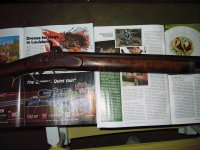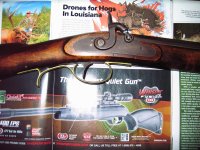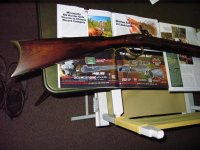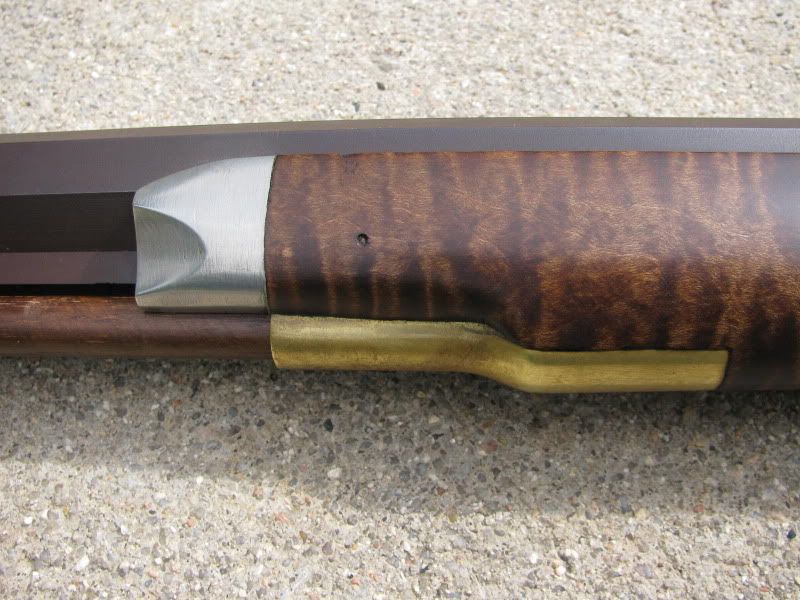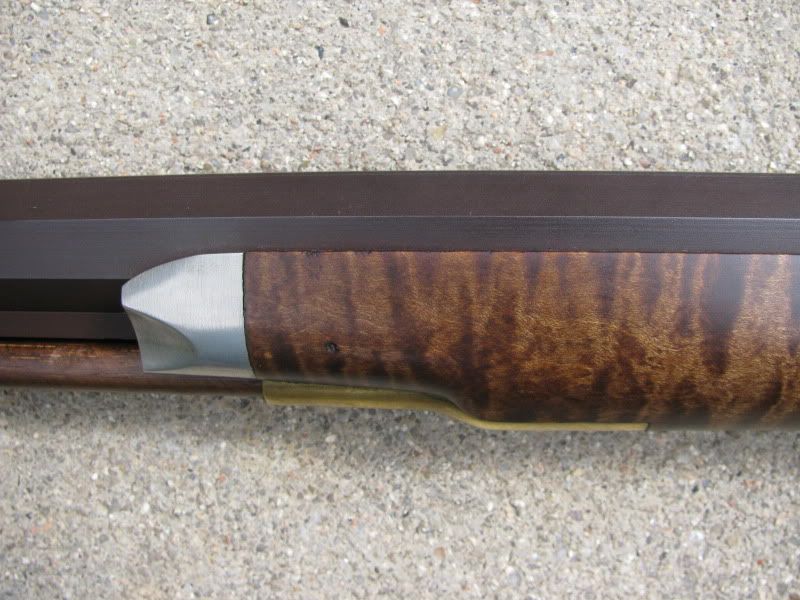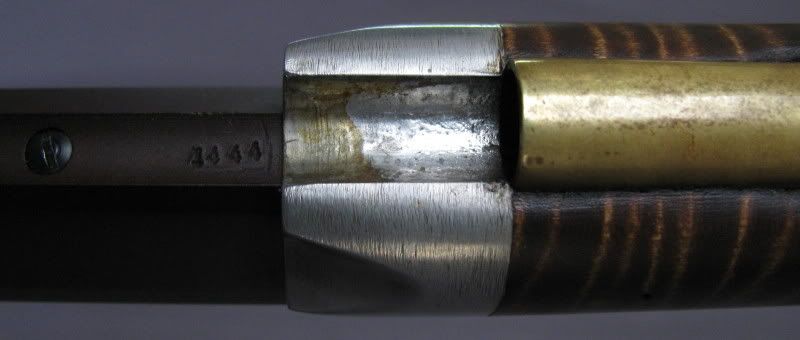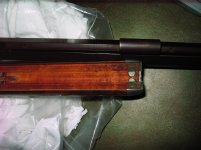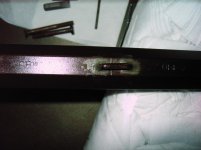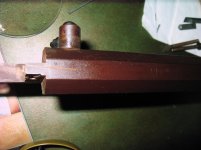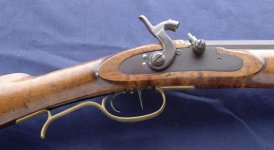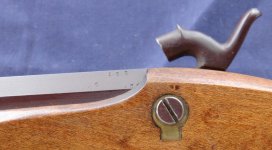You are using an out of date browser. It may not display this or other websites correctly.
You should upgrade or use an alternative browser.
You should upgrade or use an alternative browser.
Green River Rifle Works Leman Rifle information needed !
- Thread starter WIN1886
- Start date
GRRW Leman
GRRW started up in March 1972 making the Leman Trade Rifle in half stock. Early Lemans were made with a Kern coil spring lock and Douglas barrels. In 1974 GRRW started making their own barrels. Around SN 1000, they ran out of the Kern lock and started making them with Ron Long Hawken locks. Later they used Siler mountain locks. The early Lemans used commercially available butt plates and trigger guards which were a little large. Phil "Blue Jacket" Sanders was insrtumental in making some molds for new butt plates and trigger guards from an original Leman rifle in Doc White's collection. GRRW started casting their own butt plates and trigger guards which were smaller and made a slimmer rifle. They also changed the shape of the poured pewter nose cap around this time. The company went backrupt in the fall of 1980. They made a total of around 2000 Leman Trade Rifles and possibly as many as 3000.
If you can post some pictures of your rifle or email me pictures and serial number, I can tell you more detail info about your particular rifle.
GRRW started up in March 1972 making the Leman Trade Rifle in half stock. Early Lemans were made with a Kern coil spring lock and Douglas barrels. In 1974 GRRW started making their own barrels. Around SN 1000, they ran out of the Kern lock and started making them with Ron Long Hawken locks. Later they used Siler mountain locks. The early Lemans used commercially available butt plates and trigger guards which were a little large. Phil "Blue Jacket" Sanders was insrtumental in making some molds for new butt plates and trigger guards from an original Leman rifle in Doc White's collection. GRRW started casting their own butt plates and trigger guards which were smaller and made a slimmer rifle. They also changed the shape of the poured pewter nose cap around this time. The company went backrupt in the fall of 1980. They made a total of around 2000 Leman Trade Rifles and possibly as many as 3000.
If you can post some pictures of your rifle or email me pictures and serial number, I can tell you more detail info about your particular rifle.
Thanks so much.......hope these pictures help ! It is a .54 caliber and was told strictly a ball shooter....is there a good sub for FF or is it best to use blackpowder in these rifles ? Thanks !
Attachments
Last edited:
Thanks for the pictures. That is one of the later versions. It has the proprietary GRRW butt plate and trigger guard that was developed in 1974. The lock is a Siler mountain lock. The serial number should be greater than 1000 and likely greater than 1500. Most of the GRRW Lemans I have seen between 1000 and 1500 had Ron Long Hawken locks.
GRRW sold these rifles as factory finished rifles and in kits. A factory rifle will have a serial number stamped near the breech. It will also have GRRW over ROOSEVELT, UTAH stamped on the top flat either in front of or behind the rear sight. A rifle built as a kit by the customer will not have these barrel markings. A kit rifle generally only had the caliber stamped on the barrel.

If your rifle is a factory finished rifle, in addition to the serial number, there is probably a makers mark stamped on the barrel near the breech close to the caliber stamp. These can be letters for the riflesmiths initials or a symbol.
Carl Walker used a "C" lying on its side with a small "W" inside it, all inclosed in a square similar to a lazy C and W cattle brand.

Neill Fields engraved a combined NF in script like this.

Gardell Powell used a GP.
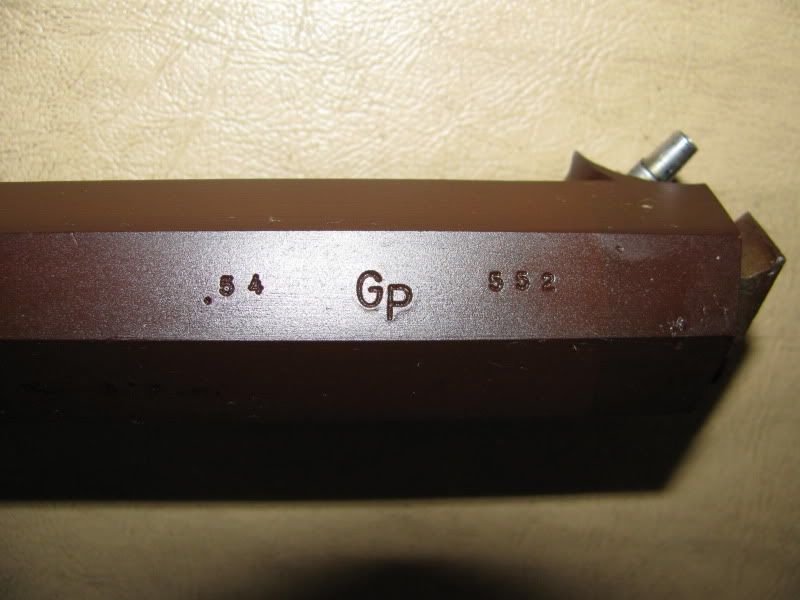
This is Bill McKay's makers mark.

Ron Paull used a "P" in an oval and also sometimes added his initials.

Pyrodex is a suitable substitute for black powder. I would recommend the RS granulation, but P could be used with reduced volume. Pyrodex should be loaded on a volume equivalent basis for black powder. A good starting load would be 80 grs of RS on a volume equivalent basis. You could work up to 100 or 120 grs for a hunting load, but likely will find 80 to 90 grs suitable for target shooting. Be sure to thoroughly clean the barrel within a day of shooting. Pyrodex is more corrosive than black powder and will pit the barrel very quickly, but both are hygroscopic and will pull water out of the air if you are in a humid climate and form corrosive acids that eat the metal.
One more thought on cleaning and oiling the rifle, water is the best solvent for black powder and Pyrodex residue. You can add a drop or two of Dawn detergent to the water if you want. Do not use any petroleum base solvent or oil for cleaning or lubing. The BP and Pyrodex powder residue is not soluble in petroleum solvents or oils like smokeless powders, and it will just form a hard cake in the bore that is difficult to remove. After the bore has been cleaned and dried, you can swab the bore with your favorite gun oil as a preservative, but clean it out with a dry patch prior to shooting it the next time to remove the oil. A better preservative for BP firearms is Ballistol Sportsman Oil. It can be used as a patch lube and cleaning solvent, also.
The barrels on these rifles have a 1 in 60 twist and are best suited to a patched round ball. You can try .530" balls with .015" or .020" patches or .535" balls with .010" or .015" patches. You can use pre-lubed patches such as those lubed with Wonder Lube or lube the patches with spit or one of the commercial black powder lubes.
Hope this info helps.
Phil Meek
GRRW sold these rifles as factory finished rifles and in kits. A factory rifle will have a serial number stamped near the breech. It will also have GRRW over ROOSEVELT, UTAH stamped on the top flat either in front of or behind the rear sight. A rifle built as a kit by the customer will not have these barrel markings. A kit rifle generally only had the caliber stamped on the barrel.

If your rifle is a factory finished rifle, in addition to the serial number, there is probably a makers mark stamped on the barrel near the breech close to the caliber stamp. These can be letters for the riflesmiths initials or a symbol.
Carl Walker used a "C" lying on its side with a small "W" inside it, all inclosed in a square similar to a lazy C and W cattle brand.

Neill Fields engraved a combined NF in script like this.

Gardell Powell used a GP.

This is Bill McKay's makers mark.

Ron Paull used a "P" in an oval and also sometimes added his initials.

Pyrodex is a suitable substitute for black powder. I would recommend the RS granulation, but P could be used with reduced volume. Pyrodex should be loaded on a volume equivalent basis for black powder. A good starting load would be 80 grs of RS on a volume equivalent basis. You could work up to 100 or 120 grs for a hunting load, but likely will find 80 to 90 grs suitable for target shooting. Be sure to thoroughly clean the barrel within a day of shooting. Pyrodex is more corrosive than black powder and will pit the barrel very quickly, but both are hygroscopic and will pull water out of the air if you are in a humid climate and form corrosive acids that eat the metal.
One more thought on cleaning and oiling the rifle, water is the best solvent for black powder and Pyrodex residue. You can add a drop or two of Dawn detergent to the water if you want. Do not use any petroleum base solvent or oil for cleaning or lubing. The BP and Pyrodex powder residue is not soluble in petroleum solvents or oils like smokeless powders, and it will just form a hard cake in the bore that is difficult to remove. After the bore has been cleaned and dried, you can swab the bore with your favorite gun oil as a preservative, but clean it out with a dry patch prior to shooting it the next time to remove the oil. A better preservative for BP firearms is Ballistol Sportsman Oil. It can be used as a patch lube and cleaning solvent, also.
The barrels on these rifles have a 1 in 60 twist and are best suited to a patched round ball. You can try .530" balls with .015" or .020" patches or .535" balls with .010" or .015" patches. You can use pre-lubed patches such as those lubed with Wonder Lube or lube the patches with spit or one of the commercial black powder lubes.
Hope this info helps.
Phil Meek
Thanks , the information is very helpful ! It looks to me like the stock is made of plain Maple and stained and finished to look darker and antiqued ( if you catch my meaning ) ! The metal components to stock fit and workmanship is excellent and the trigger pull is light and very crisp ( best I've seen in any BP rifle or many modern center fire rifles I've tried as well ) ! No , I'm not dry firing it !  If you noticed the barrel is pinned to the half stock and not wedged like I've seen of pictures of other GRRW rifles posted which has thrown me for a loop !
If you noticed the barrel is pinned to the half stock and not wedged like I've seen of pictures of other GRRW rifles posted which has thrown me for a loop !
You haven't said whether yours is a factory finished rifle are a kit gun.
Assuming it is a factory rifle, GRRW used a number of different stains over its 8+ years of operations. In the first few years, they used commercially available stains, and a majority of their rifles had a reddish, orange stain. In the middle years, they used a brownish stain. Later years they used Aqua Fortis stain and chromic acid stain. The latter can be identified by a greenish tint in the color of the stock today. The Aqua Fortis stain, in some cases, has continued to darken over time.
Your rifle may have been stained with Aqua Fortis which has darkened, giving it that antique look. Some of the high areas of the stock may be lighter due to handling.
The standard rifle came with plain maple stock, but fancy wood (striped maple) could be ordered at extra cost.
Yup, they came both ways--pinned and keyed. Based on a GRRW catalog I have, "Barrels may be either pinned or keyed to the stock. The pin is the more traditional treatment on rifles, we have observed." Since the Leman Trade Rifle has a Kentucky style fixed breech (GRRW called it a flint breech), not a hooked breech, the keyed stock was only cosmetic. Here is a picture of one with a key.

Other options available at additional cost included double set triggers and flint ignition. Your rifle appears to be the standard offering with none of the additional cost options.
I can appreciate your comment that the "workmanship is excellent" on your rifle. GRRW was a semi-custom shop. Their smiths steadily improved their skills over the years. I have some GRRW rifles in my collection that would rival custom made rifles in fit and finish.
Here is a picture of the most customized GRRW rifle I've seen. It has extra fancy wood (the nicest wood I've seen on any GRRW rifle), double set triggers, brass entry thimble, weeping heart lock bolt escutcheon, "Tennessee" style cheek rest, and left hand rifle to boot.
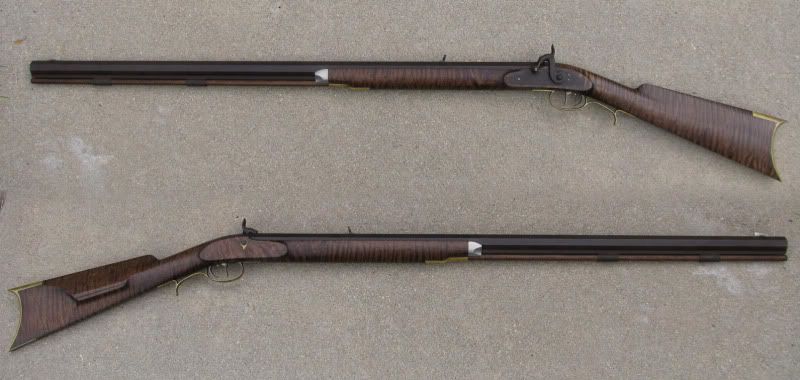
This rifle has GRRW's Leman brass furniture and is a typical Kentucky half stock rifle like Henry Leman made for the Eastern market, though some could have gone west.
Assuming it is a factory rifle, GRRW used a number of different stains over its 8+ years of operations. In the first few years, they used commercially available stains, and a majority of their rifles had a reddish, orange stain. In the middle years, they used a brownish stain. Later years they used Aqua Fortis stain and chromic acid stain. The latter can be identified by a greenish tint in the color of the stock today. The Aqua Fortis stain, in some cases, has continued to darken over time.
Your rifle may have been stained with Aqua Fortis which has darkened, giving it that antique look. Some of the high areas of the stock may be lighter due to handling.
The standard rifle came with plain maple stock, but fancy wood (striped maple) could be ordered at extra cost.
Yup, they came both ways--pinned and keyed. Based on a GRRW catalog I have, "Barrels may be either pinned or keyed to the stock. The pin is the more traditional treatment on rifles, we have observed." Since the Leman Trade Rifle has a Kentucky style fixed breech (GRRW called it a flint breech), not a hooked breech, the keyed stock was only cosmetic. Here is a picture of one with a key.

Other options available at additional cost included double set triggers and flint ignition. Your rifle appears to be the standard offering with none of the additional cost options.
I can appreciate your comment that the "workmanship is excellent" on your rifle. GRRW was a semi-custom shop. Their smiths steadily improved their skills over the years. I have some GRRW rifles in my collection that would rival custom made rifles in fit and finish.
Here is a picture of the most customized GRRW rifle I've seen. It has extra fancy wood (the nicest wood I've seen on any GRRW rifle), double set triggers, brass entry thimble, weeping heart lock bolt escutcheon, "Tennessee" style cheek rest, and left hand rifle to boot.

This rifle has GRRW's Leman brass furniture and is a typical Kentucky half stock rifle like Henry Leman made for the Eastern market, though some could have gone west.
Separating the barrel from the stock....is it necessary to do this for cleaning after use ? It seems the pinned barrel would be more fragile and wear out the stock pinning hole faster than the keyed version with lots of use ! I take it you use great care in driving out the pin....is it tapered ? This must be a kit gun because there are no visible marks on the browned barrel ...could any be hidden by the stock ?
WIN1886, it isn't necessary to take the barrel out of the stock to clean it. One option to clean the barrel is to plug the nipple with a toothpick or some suitable soft round material to make a water tight seal. Hold the rifle upright and carefully pour warm water down the barrel. I usually wrap a towel around the barrel near the muzzle to absorb any water I spill. Let the water soak for a few minutes. Hold your thumb over the muzzle and upright the rifle to slosh the water up and down the barrel. Pour the water out and run a wet patch down the bore with a tight fitting jag. Repeat the water and swabbing with the patch until the patch is relatively clean. Run dry patches down the barrel until the barrel is dry. Run a patch saturated with your preferred rust preventative down the bore. Remove the toothpick and clean around the nipple, drum, breech end of barrel, and lock with wet patch. Dry, oil, and you're done. If you use a petroleum base oil as rust preventative, remember to clean it out with a dry patch before you load for the next shooting session.
Another method is to get a "flush nipple" like this one from Track of the Wolf.
http://www.trackofthewolf.com/Categories/PartDetail.aspx/578/1/FLUSH-RST
You attach rubber or plastic tubing, such as surgical tubing, to the flush nipple and screw it in place of the regular nipple. Place the loose end of the tubing into a bucket of water. Put a tight fitting patch on your cleaning jag and run it down the barrel. It should be tight enough to displace air out of the barrel and through the tubing and bubble the water. Slowly pull the rod and jag up the bore of the rifle, pulling water up the tubing and into the barrel. Keep working this pumping action, flushing the barrel with water. Change patch if you start loosing suction. When you feel you've loosened and flushed the fouling out, throw out the dirty water and replace with clean water and repeat the flushing action. I like to add a cap full of Ballistol to this rinse water. It keeps the barrel from flash rusting. Dry the barrel with dry patches and oil it with the rust preventative. Clean drum, breech, and lock and wipe with oil.
If you do want to take the barrel out of the stock to inspect it, you will need a pin punch that is smaller than the diameter of the pin. The pin in the stock is not tapered, but its ends should be rounded so it doesn't catch the wood and splinter out a piece. Carefully drive out the pin. I always drive the pin out towards the left or off side and replace in opposite direction. Don't try to remove the barrel yet!!
You need to remove the lock bolt and the tang bolt because both are holding the breech end of the barrel to the stock. See photo below.
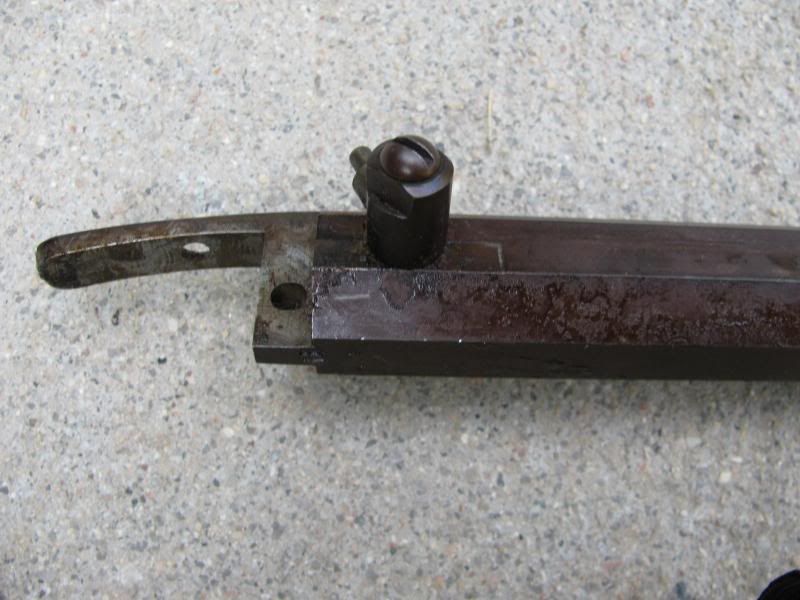
To remove the barrel once the pin and these two bolts are out, you should turn the gun upside down holding it about midway down the barrel with one hand and near the lock area with the other hand. Gently drop the rifle onto a padded surface so that the wrist area hits the padded surface. What you want to do is let inertia loosen the tang and breech of the barrel from the stock. Once the tang is out of the inlet in the stock, then lift the rest of the barrel out of the stock. You do not want to try to remove the barrel by pulling up on the muzzle end. This can turn the barrel into a pry bar and place enough leverage onto the tang to bend it or even break it where it has been drilled for the tang bolt. You also run the risk of chipping out a piece of wood at the end of the tang due to the pressure.
Now you can fully inspect the barrel, tang, drum and nipple for any rust, old oil, or other gunk like on the barrel in the picture above. You can also look for any other barrel markings on the bottom of the barrel.
I think you can see that with this type of breech plug, a key isn't much of an advantage over a pin when one wants to remove the barrel. There is as much risk of damaging the tang or the wood around the tang as there is in damaging the wood around the pin. It can be done without any harm if you are very careful. You wouldn't want to do it for every cleaning, though.
On factory finished rifles, the company logo and address is normally stamped on the top flat of the barrel. The caliber, serial number, and makers mark are normally stamped on the off side oblique flat near the breech. If a customer requested it, the stamps could be hidden on the bottom flats. I have one GRRW rifle like this.
If your rifle doesn't have these stamps, then it was likely a kit that was assembled by the buyer. Some people that bought these kits from GRRW were very skilled craftsmen, often experienced rifle builders, and put together a high quality rifle. Yours sounds like one of these.
Phil
Another method is to get a "flush nipple" like this one from Track of the Wolf.
http://www.trackofthewolf.com/Categories/PartDetail.aspx/578/1/FLUSH-RST
You attach rubber or plastic tubing, such as surgical tubing, to the flush nipple and screw it in place of the regular nipple. Place the loose end of the tubing into a bucket of water. Put a tight fitting patch on your cleaning jag and run it down the barrel. It should be tight enough to displace air out of the barrel and through the tubing and bubble the water. Slowly pull the rod and jag up the bore of the rifle, pulling water up the tubing and into the barrel. Keep working this pumping action, flushing the barrel with water. Change patch if you start loosing suction. When you feel you've loosened and flushed the fouling out, throw out the dirty water and replace with clean water and repeat the flushing action. I like to add a cap full of Ballistol to this rinse water. It keeps the barrel from flash rusting. Dry the barrel with dry patches and oil it with the rust preventative. Clean drum, breech, and lock and wipe with oil.
If you do want to take the barrel out of the stock to inspect it, you will need a pin punch that is smaller than the diameter of the pin. The pin in the stock is not tapered, but its ends should be rounded so it doesn't catch the wood and splinter out a piece. Carefully drive out the pin. I always drive the pin out towards the left or off side and replace in opposite direction. Don't try to remove the barrel yet!!
You need to remove the lock bolt and the tang bolt because both are holding the breech end of the barrel to the stock. See photo below.

To remove the barrel once the pin and these two bolts are out, you should turn the gun upside down holding it about midway down the barrel with one hand and near the lock area with the other hand. Gently drop the rifle onto a padded surface so that the wrist area hits the padded surface. What you want to do is let inertia loosen the tang and breech of the barrel from the stock. Once the tang is out of the inlet in the stock, then lift the rest of the barrel out of the stock. You do not want to try to remove the barrel by pulling up on the muzzle end. This can turn the barrel into a pry bar and place enough leverage onto the tang to bend it or even break it where it has been drilled for the tang bolt. You also run the risk of chipping out a piece of wood at the end of the tang due to the pressure.
Now you can fully inspect the barrel, tang, drum and nipple for any rust, old oil, or other gunk like on the barrel in the picture above. You can also look for any other barrel markings on the bottom of the barrel.
I think you can see that with this type of breech plug, a key isn't much of an advantage over a pin when one wants to remove the barrel. There is as much risk of damaging the tang or the wood around the tang as there is in damaging the wood around the pin. It can be done without any harm if you are very careful. You wouldn't want to do it for every cleaning, though.
On factory finished rifles, the company logo and address is normally stamped on the top flat of the barrel. The caliber, serial number, and makers mark are normally stamped on the off side oblique flat near the breech. If a customer requested it, the stamps could be hidden on the bottom flats. I have one GRRW rifle like this.
If your rifle doesn't have these stamps, then it was likely a kit that was assembled by the buyer. Some people that bought these kits from GRRW were very skilled craftsmen, often experienced rifle builders, and put together a high quality rifle. Yours sounds like one of these.
Phil
Hey plmeek...take a look at these pictures ! I was too curious so I had to remove the barrel to see what was underneath...I found GRRW lightly stamped in three places but nothing else so far ! A picture of my nose cap included ! The fit was nice and tight so even with hardware removed I followed your instructions and with gentle persuasion the barrel finally came free ! As mentioned , even if this is a kit gun it was done right ( special thanks to the craftsman) ! Thanks !
Attachments
Last edited:
WIN1886, your photos are interesting.
I've been collecting and studying GRRW and its guns for several years now. I usually learn something new with every GRRW rifle/pistol I come across.
Below is the GRRW stamp on a barrel of a half stock Hawken kit I purchased from GRRW in 1979. It is lightly stamped like the ones on your rifle. The best I can tell, they are the same stamp.

I have two other GRRW kits I ordered in 1979 and 1980. The barrels in these two kits only have the caliber stamp, no company logo. Your rifle is the only other kit gun I've seen with this stamp besides my kit Hawken. I can't explain why they would have stamped it three times. The worker that stamped it might have been trying to get a good clear stamp.
GRRW had a machine shop that made the barrels, installed the breech plugs, made and installed the barrel loops or staples the pin goes through, and installed the underrib and thimbles. They also performed this same work on the barrels in their kits. The barrel came from the factory ready to install. All the customer had to do was final fitting of the barrel in the stock and drill and tap holes for the tang and lock bolts and brown the barrel. The customer also had to do the final inletting on the other metal parts and pour the pewter nose cap. This particular model was offered in a kit where the stock was fully shaped and 95% inlet. Here is an ad from 1979 for the kit like your rifle. I would guess that your rifle dates from this period.
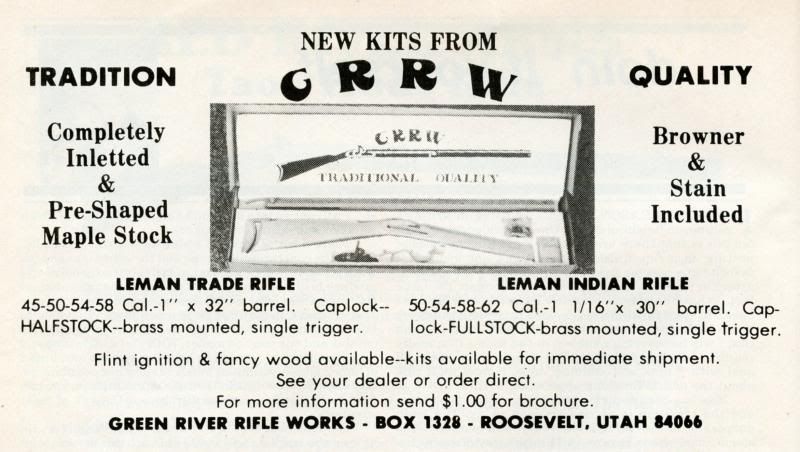
I've been collecting and studying GRRW and its guns for several years now. I usually learn something new with every GRRW rifle/pistol I come across.
Below is the GRRW stamp on a barrel of a half stock Hawken kit I purchased from GRRW in 1979. It is lightly stamped like the ones on your rifle. The best I can tell, they are the same stamp.

I have two other GRRW kits I ordered in 1979 and 1980. The barrels in these two kits only have the caliber stamp, no company logo. Your rifle is the only other kit gun I've seen with this stamp besides my kit Hawken. I can't explain why they would have stamped it three times. The worker that stamped it might have been trying to get a good clear stamp.
GRRW had a machine shop that made the barrels, installed the breech plugs, made and installed the barrel loops or staples the pin goes through, and installed the underrib and thimbles. They also performed this same work on the barrels in their kits. The barrel came from the factory ready to install. All the customer had to do was final fitting of the barrel in the stock and drill and tap holes for the tang and lock bolts and brown the barrel. The customer also had to do the final inletting on the other metal parts and pour the pewter nose cap. This particular model was offered in a kit where the stock was fully shaped and 95% inlet. Here is an ad from 1979 for the kit like your rifle. I would guess that your rifle dates from this period.

Buck Conner
New member
plmeek,
I have a GRRW Leman flinter fullstock that Doc built for me ordered in 1972 received in 1973 while still in Boulder CO which he left the GRRW and CO address off the barrel per my request but demanded the caliber be left on barrel. This was not a kit gun.
I had a second GRRW Leman percussion halfstock built later in 1973 that was purchased with marking you mention. Sold it like we all do and now wished I had it back.
A friend has a low two digit serial number Hawken halfstock percussion that was purchased at the same time as my first GRRW gun with marking you mentioned.
Another friend has the first Hawken fullstock flinter Doc built in 1972 or receive in early 1973 with no serial number or markings other the name can't remember exactly but like "Death Wish" or "Death Smoke" on top of the barrel.
I have a third GRRW Leman flinter fullstock now built in 1974-75 with no markings on the barrel (kit gun like you have stated) caliber on left side of barrel only purchased recently from an old friend.
I was one of three of Doc's dealers in the early years in northern Colorado "Buckhorn Rendezvous", Masonville CO, as was Mike McCormick - "Cache La Poudre Rifleworks", FT Collins CO. and Mountain Armory also Ft Collins.
Fun times dealing with Doc in Boulder, talk to him a few times a year. My wife's cousin is Doc's pardner with "White In-Line Rifles", still have parts for complete guns stored in Provo UT.
I have a GRRW Leman flinter fullstock that Doc built for me ordered in 1972 received in 1973 while still in Boulder CO which he left the GRRW and CO address off the barrel per my request but demanded the caliber be left on barrel. This was not a kit gun.
I had a second GRRW Leman percussion halfstock built later in 1973 that was purchased with marking you mention. Sold it like we all do and now wished I had it back.
A friend has a low two digit serial number Hawken halfstock percussion that was purchased at the same time as my first GRRW gun with marking you mentioned.
Another friend has the first Hawken fullstock flinter Doc built in 1972 or receive in early 1973 with no serial number or markings other the name can't remember exactly but like "Death Wish" or "Death Smoke" on top of the barrel.
I have a third GRRW Leman flinter fullstock now built in 1974-75 with no markings on the barrel (kit gun like you have stated) caliber on left side of barrel only purchased recently from an old friend.
I was one of three of Doc's dealers in the early years in northern Colorado "Buckhorn Rendezvous", Masonville CO, as was Mike McCormick - "Cache La Poudre Rifleworks", FT Collins CO. and Mountain Armory also Ft Collins.
Fun times dealing with Doc in Boulder, talk to him a few times a year. My wife's cousin is Doc's pardner with "White In-Line Rifles", still have parts for complete guns stored in Provo UT.

